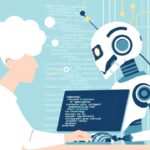The Future of AI and Jobs: Insights from AI Leaders Jensen Huang and Sam Altman
1. Intro: The AI Revolution and the Workforce
The future of AI and jobs is on everyone’s mind. AI is rapidly transforming industries, and leading figures like Jensen Huang and Sam Altman are at the forefront of this technological revolution. As AI continues to evolve, questions about its impact on employment are more relevant than ever. Let’s dive into what these AI leaders have to say and explore how AI might shape our future workplaces.
2. Understanding Jensen Huang’s Vision
2.1. A Brief Introduction to Jensen Huang
Jensen Huang is the co-founder and CEO of NVIDIA, a company that’s become synonymous with advancements in graphics processing units (GPUs) and AI technology. His insights into the future of AI are both insightful and pragmatic. In a recent interview, Huang discussed AI’s potential to revolutionize traditional industries and create new opportunities. He believes that AI, when used correctly, can augment human capabilities rather than replace them.
2.2. The Role of AI in the Future Workforce
Huang often speaks about how AI can enhance productivity and efficiency. For example, consider a surgeon. AI systems can help surgeons make more precise diagnoses and perform complex surgeries with greater accuracy. Instead of replacing the surgeon, the AI acts as a potent tool, improving outcomes and making the surgeon’s job easier. This is the essence of AI augmentation.
Moreover, Huang believes that AI will create new roles and industries that we’ve yet to imagine. Industries like autonomous driving, personalized healthcare, and smart cities will all require new skill sets and job roles. While some jobs may become obsolete, others will emerge to replace them, and existing roles will evolve to incorporate AI.
- The Role of AI in Healthcare
- A New Era of Personalized Medicine
- The Impact on Surgeons’ Roles and Effectiveness
Take the automotive industry, for instance. The advent of autonomous vehicles will change the need for human drivers drastically, but it will also create jobs in AI development, vehicle maintenance, and customer support for autonomous systems.
3. Sam Altman on AI and Employment
3.1. Who is Sam Altman?
Sam Altman is a prominent figure in the tech world, best known as the former president of Y Combinator, the world’s most influential startup accelerator. He’s also the CEO of OpenAI, a leading AI research laboratory. Altman’s views on the future of AI and jobs are nuanced and thought-provoking. He often discusses the dual nature of AI—to empower and disrupt.
3.2. The Benefits and Challenges of AI in the Workforce
Altman acknowledges that AI will likely automate many routine jobs, from administrative tasks to manufacturing processes. However, he also notes that AI can open doors to new opportunities. Rather than fearing AI, Altman suggests we should focus on preparing for it by investing in education and lifelong learning.
For example, imagine a customer service representative who relies on repetitive tasks like answering common questions. An AI system can handle these tasks, freeing the representative to focus on complex issues that require human empathy and problem-solving skills. This shift means customer service reps need to upgrade their skills to handle more intricate cases.
3.3. Preparing for an AI-Driven Future
Altman believes strongly in continuous learning. As AI continues to evolve, so must our skill sets. Education systems need to adapt to teach skills that are complementary to AI, such as creativity, critical thinking, and adaptability. Altman often advocates for universal basic income as a way to cushion the impact of job displacement caused by AI. This is a controversial topic, but it underscores the need for innovative solutions in an AI-driven world.
3.4. The Importance of Human-AI Collaboration
Collaboration between humans and AI is another crucial aspect of Altman’s vision. He emphasizes that AI should be seen as a tool to enhance human capabilities rather than a replacement. For instance, in the field of data analysis, AI can process vast amounts of data quickly, but humans are needed to interpret the results and make strategic decisions. This partnership can lead to more accurate and insightful outcomes.
The success stories of platforms like OpenAI demonstrate how collaborative work between humans and AI can lead to groundbreaking advancements. Altman’s vision is about leveraging the strengths of both humans and machines to create a more efficient and innovative work environment.
4. How Industries Are Preparing for AI
4.1. Healthcare
In healthcare, AI is already making significant strides. AI systems can analyze medical images with high accuracy, assist in drug discovery, and even provide predictive analytics for patient outcomes. This allows medical professionals to focus on patient care and complex diagnoses, enhancing overall healthcare delivery.
4.2. Manufacturing
The manufacturing industry is another area where AI is transforming operations. AI-driven robots can perform repetitive tasks with precision and consistency, reducing the burden on human workers. This shift allows humans to focus on more creative and strategic aspects of manufacturing, such as design and quality control.
4.3. Finance and Banking
In the finance sector, AI is used for fraud detection, risk management, and personalized financial advice. AI algorithms can analyze vast amounts of data to identify potential fraudulent activities, making the financial system more secure. Additionally, AI-driven personal financial advisors can provide tailored advice to individual customers, improving customer satisfaction and trust.
A Real-World Example: Selling AI Solutions to Businesses
There are many businesses that have implemented AI solutions to upgrade their effectiveness. Returning to manufacturing, AI cameras and robots installed on vehicles in factories lend vision and speed to repetitive, mostly laborious tasks. Not only does this benefit the companies who have implemented this new technology, but it benefits their competitors allowing them to establish a status quo in the realm of product manufacturing. Not implementing AI technology would be akin to driving a horse and carriage to a race won by a combustion-engine car – it would put your business at a competitive disadvantage.
5. The Human Element: What AI Can’t Replace
While AI is powerful, it can’t replace the human element completely. Skills like empathy, creativity, and ethical decision-making are uniquely human. In fields like psychology, social work, and the arts, human intuition and emotional intelligence are irreplaceable. AI can assist in these areas, but it can’t fully replicate human interaction and understanding.
For instance, a therapist uses empathy and emotional intelligence to help clients navigate mental health challenges. AI can provide tools and data to support this process, but the core of therapy—building trust and emotional connection—remains a human domain.
- Empathy in Client Services
- The Necessity of Emotional Intelligence
- A Human-First Approach for Technology
6. What Should Workers Do to Prepare?
6.1. Develop Digital Literacy
Digital literacy is becoming as essential as basic reading and writing. Workers should familiarize themselves with AI tools and technologies relevant to their field. This doesn’t mean becoming an AI expert but understanding how these tools can be integrated into daily tasks and workflows.
6.2. Continuous Learning and Skill Upgrading
Continuous learning is key to staying relevant in an AI-driven world. Workers should invest in upskilling and reskilling programs. Online courses, workshops, and certifications can help individuals acquire new skills and stay updated with the latest technological advancements. A curious mindset and a willingness to learn can make all the difference.
6.3. Embrace Flexibility and Adaptability
In a rapidly changing work environment, being adaptable is crucial. Workers should be open to new roles and responsibilities, even if they differ from their current positions. Embracing flexibility can open doors to new opportunities and career growth. It’s about being agile and ready to pivot when necessary.
6.4. Focus on Human Strengths
While AI excels in data processing and automation, humans excel in creativity, empathy, and strategic thinking. Workers should focus on honing these unique skills and leveraging them in their roles. Collaborating with AI to enhance productivity and innovation is the way forward.
7. Conclusion: Embracing the Future with AI
The future of AI and jobs looks promising, and AI leaders like Jensen Huang and Sam Altman provide valuable insights into how we can prepare for it. AI isn’t a threat but an opportunity. It can augment human capabilities, create new roles, and enhance productivity across various industries. By embracing continuous learning, developing digital literacy, and focusing on human strengths, workers can thrive in an AI-driven world.
Remember, the future isn’t about humans vs. AI but humans with AI. Together, we can create a more efficient, innovative, and human-centric work environment. So, let’s embrace the future with optimism and an open mind. After all, the best is yet to come.










